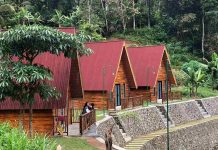Have you heard about an architectural beauty temple in Yogyakarta? Of course yes! It is Candi Sambisari. It belongs to Hindhus temple. We call it unique temple because the location is underground.
This temple is located approximately 6.5 meter below ground level that make it cannot be seen from the surface. As conjecture, it was covered by sands and rocks because of the Mount Merapi’s eruption long time ago (year 1006). That’s what makes Candi Sambisari is buried and being lower from the former ground level. Now, the temple is already dig by the citizen nearby and formed to be a rectangular courtyard with a ladder in all four sides.
The location is in Sambisari village, Purwomartani, Kalasan, Sleman Regency. From the city center, it is 15 kilometers away to north east of Yogyakarta. This temple was expected built in the beginning of 9th century by Rakai Garung (a Hindhus-Mataram King from Syailendra dynasty).
The temple’s complex are one main temple and three seconder temples. There are also eight “Lingga Patok” (a permanent anvil) in every compass directions. One-time you look into the temple, it looks like a castle in the middle of courtyard. Because there are green fields around the complex as if the royal palace with the temple centralized in that square.
When you step up into the main temple, you will see lion sculpture and makara (it is believe in as a mythical creature in Hindhus’ culture). And after, there is also space spanned a meter width.
In the north side, there is Durga Statue. Dewi Durga is Syiwa’s wife. It has eight hands holding a weapon in each arms. Then, in east side there is Ganesha Statue and also Agasty Statue in south side wearing Hindhus’ necklace.
Inside the main temple, there is Lingga and Yani (symbols of its culture). It is functioned as a veneration place of Syiwa. Outside the main temple, you will find three-seconder temple in the west side.
This temple is one of beautiful temple in Yogyakarta. It is already crowdedly visited by tourists for holiday, refreshing, or taking a photograph. (san/rag)




